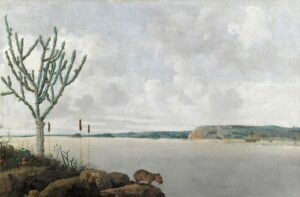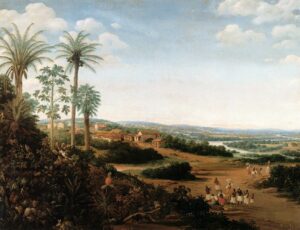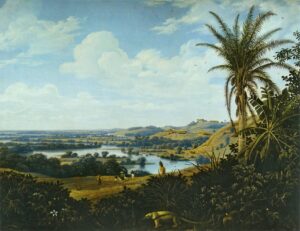Frans Post, a 17th century Dutch painter, travelled to Brazil in 1636 as a part of the colonial Governor’s entourage. His mission was to visually record the fauna, flora, and environment of Brazil.1 He returned to the Netherlands in 1644, having only completed 6 paintings. The majority of his work came afterwards, as he produced over a hundred more paintings of Brazil throughout the rest of his career. However, as Stepan notes, the character of his post-Brazil work differs greatly from the work produced while living there.2 By comparing works from each period, we can see the construction of an imaginary tropics in action.

The Old Portuguese Forte dos Reis Magos, or Fort Ceulen, at the Mouth of the Rio Grande, by Frans Post 1638

The Rio São Francisco and Fort Maurits, with a Capybara in the Foreground, by Frans Post 1639
Both produced during his time in Brazil, these two paintings share characteristics common to Post’s early work. Firstly they share a muted colour palette, both dominated by a grey, cloudy sky. The water which is featured prominently in both paintings is similarly coloured. Secondly, they focus on identifiable, real locations. The presence of forts and identifiable physical features lends these paintings a sense of grounded reality. There is little of what David Arnold would call “tropicality”, the construction of the tropics in the western mind as an “other” based on depictions in literature and art, as there is no juxtaposition with “normal” temperate lands.3 Here, Brazil is represented not dissimilarly to how contemporary landscapes of Europe would be. Post’s early paintings appear to honestly depict the landscape and life of colonial Brazil, fulfilling his mission in the New World.

The Home of a “Labrador” in Brazil, by Frans Post 1650-55

Brazilian landscape with anteater, by Frans Post 1649
Considering these works painted after Post arrived back in Europe, a shift in tone is obvious. The sky is no longer oppressive and grey, but blue and expansive. This feeling of space is also aided by situating the viewpoint high up as to reveal the landscape sprawling before the viewer. In addition, the locality of the paintings becomes more ambiguous. Post’s post- Brazil work almost unanimously depicts generic scenes of Brazil, rather than real locations. A third noticeable difference is the increase of flora in the painting foregrounds, as palms and ferns replace the waterways which took precedent in Post’s earlier work. “Tropicality” had clearly taken a toll on the authenticity of Post’s work, as values commonly associated by with the tropics by the seventeenth century European masses seep into the artwork and take on an exaggerated form.
The clear, blue skies firstly evoke sun and heat, characteristics which had been linked to the tropics since Hippocrates.4 The real Brazil has a number of different biomes and climates which are not represented by Post, who instead chooses to essentialize Brazilian weather to conform with commonly held perceptions. In conjunction with the sprawling landscapes, however, the paintings gain a double meaning, as they emphasize the openness of the tropical world. In the seventeenth century mind therefore, the tropics took on a promise of adventure and reward, with wide horizons of endless opportunity. The depiction of endless empty land can be argued to be an invitation for conquest of it, or the claiming of a monetary or political fortune. The tropics can thus be seen to have had an allure of potentiality in Post’s time.
The greater presence of foliage in the latter paintings speaks to the expectations of fertility and abundance in the tropics. Dense underbrush and towering megafauna were clearly already quintessential images associated with tropical landscapes. Compared to the restrained representations of foliage in The Rio São Francisco and Fort Maurits, with a Capybara in the Foreground, these examples seem to over exaggerate the presence of plants in the Brazilian landscape, playing to these expectation of fertility rather than honestly depicting floral specimens. There is also a reliance on the image of the palm tree, which had become an icon of the tropics, over any other type of flora across Post’s later work. He had clearly departed from his original aim of accurately capturing Brazilian life, and sought instead to create landscapes which were expected of Brazil. Alongside the new focus on non-specific scenes of Brazil, this can be taken as evidence of Post’s new commitment to an imaginary Brazil.
It is unclear whether the stark differences in Post’s paintings from his stay in Brazil and after should be attributed to the market for which he was painting, the effects of popular tropical conceptions on his own memories of Brazil, or a combination of factors. Regardless, a comparison between these two periods of his work clearly demonstrates the work of popular discourse and imagining on representations of the tropics in seventeenth century Europe.
- Frans Post (about 1612 – 1680) | National Gallery, London [↩]
- Nancy Leys Stepan, Picturing Tropical Nature (London, 2001), p. 19. [↩]
- David Arnold, The Tropics and the Traveling Gaze: India, Landscape, and Science, 1800-1856 (Seattle, 2006) [↩]
- Hippocrates, Airs, Waters, Places [↩]